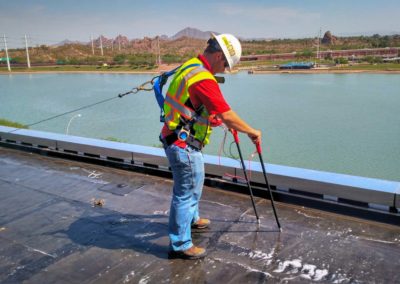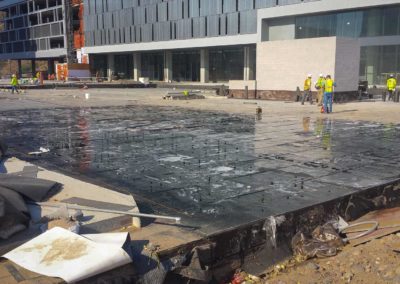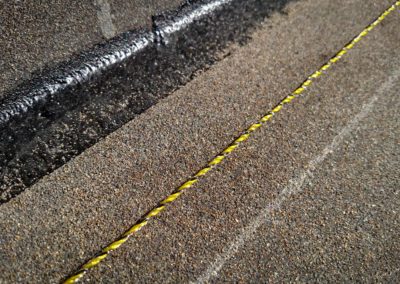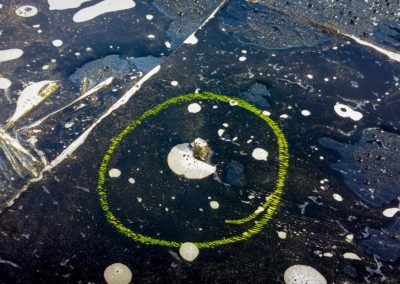Roof Integrity Testing
There are few things worse than a new roof that leaks, fails or blisters. And nothing is more urgent than when those issues finally and suddenly allow water into the building. Critical Facilities like data centers, hospitals and universities can’t afford to wait to repair a roof until after the leak has occurred.
Roof Assessment
Field Verified will perform a survey of the existing roof and roof penetrations to identify current issues and sources of potential future issues. This effort will include a review of existing roof penetrations, roof top equipment mounts and roof terminations, parapet wall coping, perimeter flashing, roof membrane condition and other adjacent roof conditions that may affect the watertight integrity of the building.
The report can be provided within 2 days of completing the survey. Several roof consultants will be committed to this effort. The results of this effort will be included in a comprehensive report detailed below.

RECOMMENDATIONS
Roof maintenance, repairs and replacement recommendations will be projected for a ten-year period and provided in the report for each roof component. This will include the estimated remaining service life (ERSL) and recommended replacement date that is outside of the ten-year plan period for any applicable components.
Projected cost of repairs will be provided for each condition and provided in a comprehensive spreadsheet. Basis of Design repair materials will be listed as well.
SUMMARY REPORT AND DETAILED ROOF PLAN
Field Verified will provide a full report of the Roof Condition Survey results on a roof plan document of the roof area. The report will include photographs of the roof field, details and existing defects for documentation and future reference. All photos will be electronically linked to the exact location on a roof plan or aerial view. Similarly, all deficiencies will be physically marked on the roof and their location documented on the roof plan.
A narrative summary will be included in the report and include a description of the testing, any areas excluded from testing do to inadequate access, the extent of the survey, the general findings of each and any recommendations.
The report format will allow for the inclusion of any photos provided by the contractor or captured during or after repairs. If the Roof Moisture scan is conducted, areas of elevated moisture will be marked and photo of the condition will be attached.
Electronic Leak Detection
Electronic Leak Detection (ELD) utilizes two innovative processes (Low Voltage ELD and High Voltage ELD) to accurately locate leaks in roofing and waterproofing membranes. Using ELD, even pinhole sized leaks are precisely identified at their point of entry along the surface of the membrane, eliminating the need to follow a leak from an interior point of water manifestation. In most cases, ELD allows for immediate repairs and re-testing. Low Voltage ELD Testing uses a wet membrane surface. High Voltage ELD Testing operates on dry surfaces. These processes eliminate the need for the high volume of water necessary for flood testing. On most projects, ELD is the fastest, most accurate, and most cost effective leak detection available.
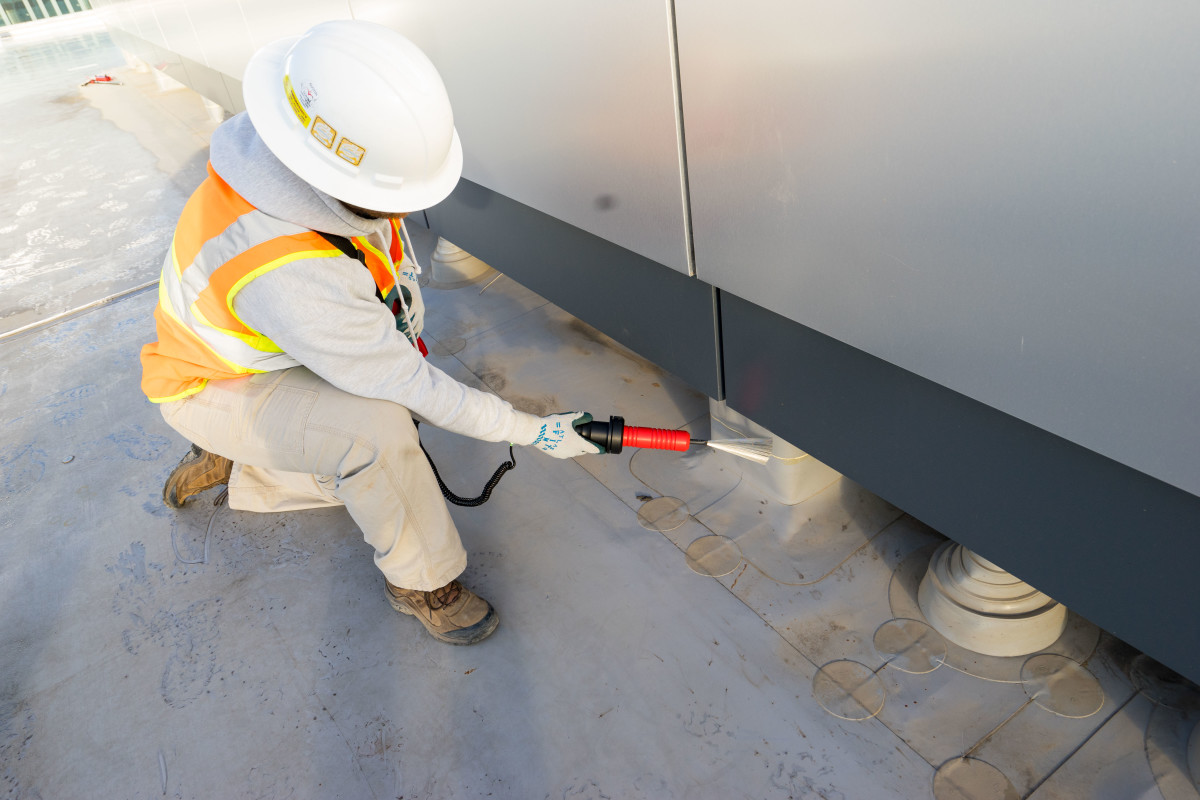
Detection Anywhere
Field Verified’s ELD allows for efficient and precise leak detection anywhere on a construction jobsite.
Big or Small
Our ELD is fast and cost-effective, making it the top choice for testing on any size construction project.
Set the Perimeter
This perimeter wire is set with a low voltage charge creating an electrical field on the membrane surface.
LOW VOLTAGE ELD
Low Voltage ELD, also known as Electronic Field Vector Mapping, is performed on roofing or waterproofing membranes installed over an electrically conductive decking. The perimeter wire is laid on the membrane around the test area, and the test area is sprayed with water to wet the membrane surface. A small electrical generator charges the perimeter wire with a low voltage, pulsating charge. This condition creates an electrical field on the membrane surface in the test area that is only insulated from the deck by the membrane.
The electrical field on the membrane surface grounds to the deck through any hole in the membrane. An ELD technician uses electrical detection equipment to precisely locate the points where the electrical charge has grounded to the conductive deck through holes in the membrane. After repairs, re-testing is performed in the appropriate areas.
HIGH VOLTAGE ELD
High Voltage ELD is also performed on roofing or waterproofing membranes installed over electrically conductive decking. A small electrical generator is connected to the conductive deck under the membrane. The generator sends a small, but relatively high voltage, charge through a copper alloy brush electrode. (This brush electrode looks like a push broom with copper bristles.) As the brush electrode is moved over the membrane, the equipment indicates when the charge has penetrated through a hole in the membrane and grounded to the conductive deck.
The location of the penetration can be narrowed down even further by using a smaller brush electrode and/or changing the direction with which the brush electrode passes over the penetration. Smaller, longer brush electrodes are used on smaller, more difficult areas such as post bases, pipe penetrations, and other transitions. No water is required for the High Voltage ELD process.
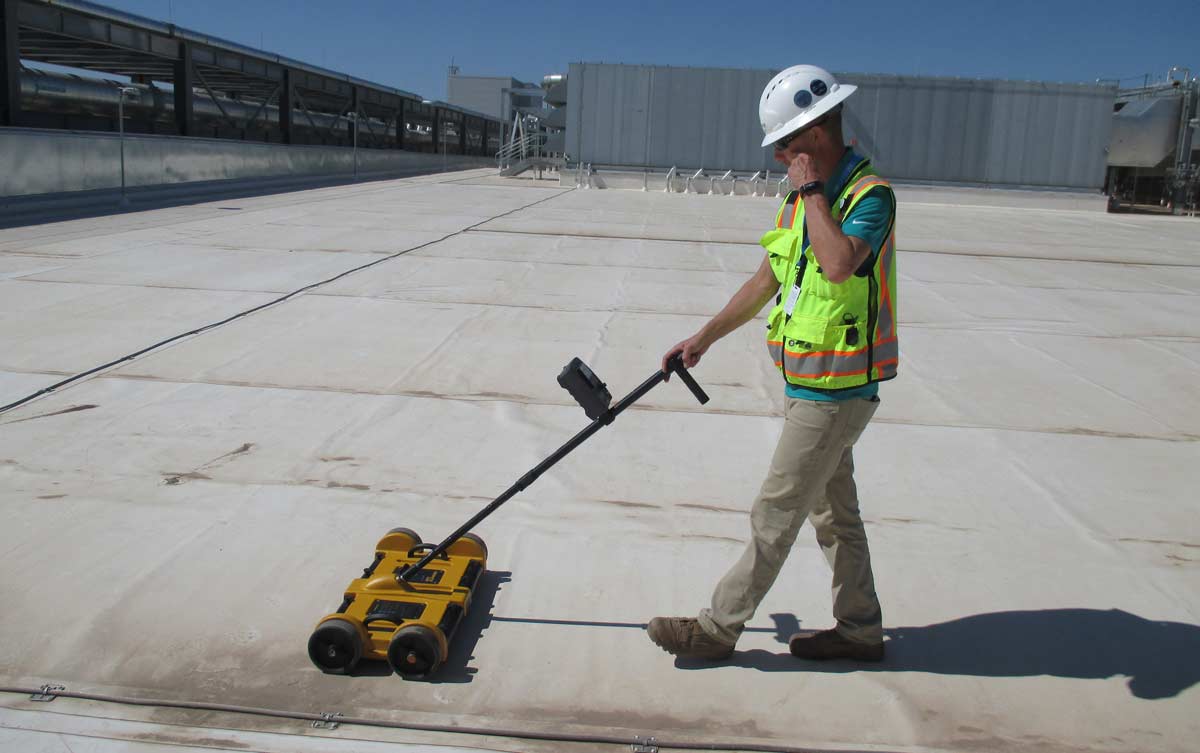
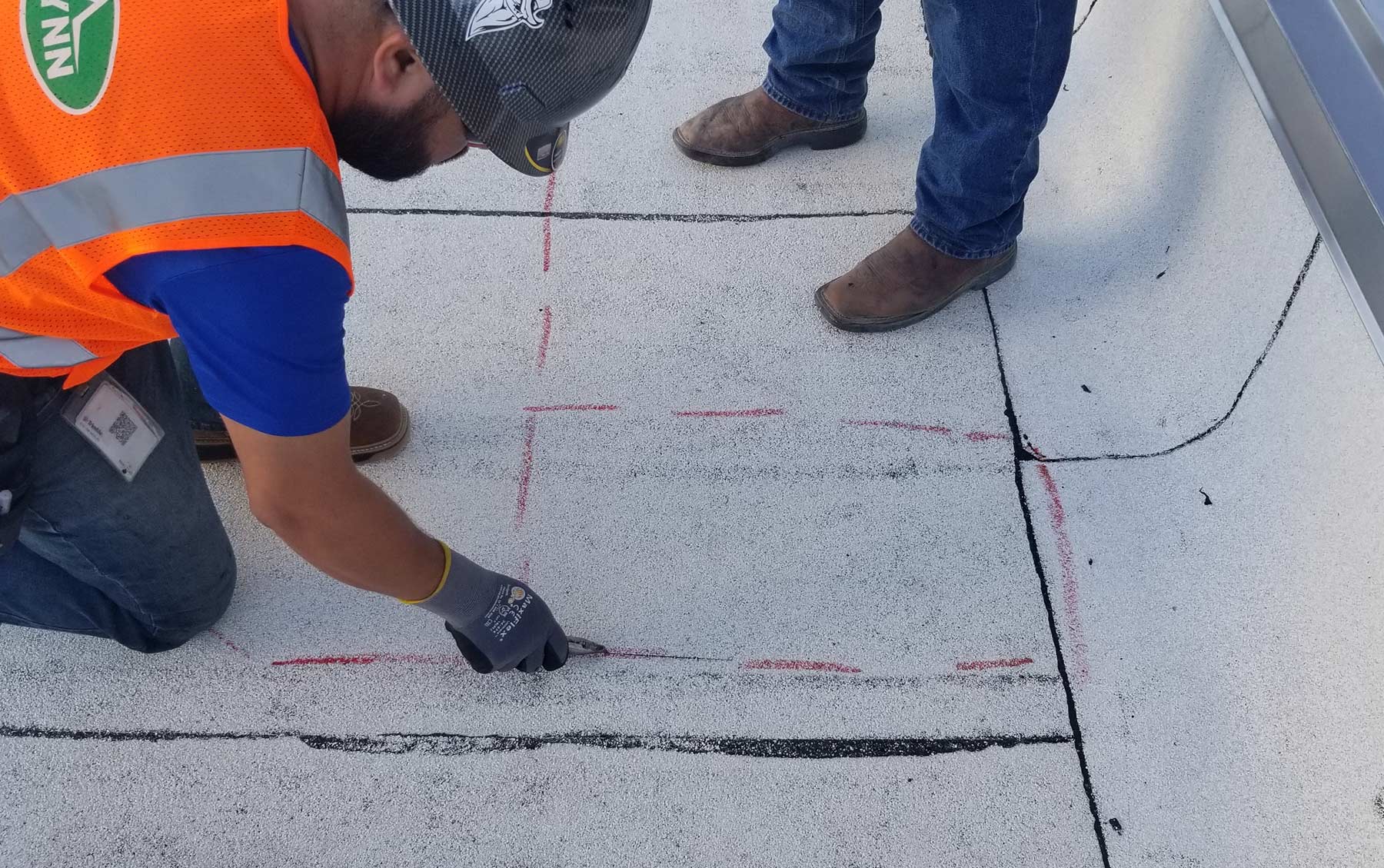
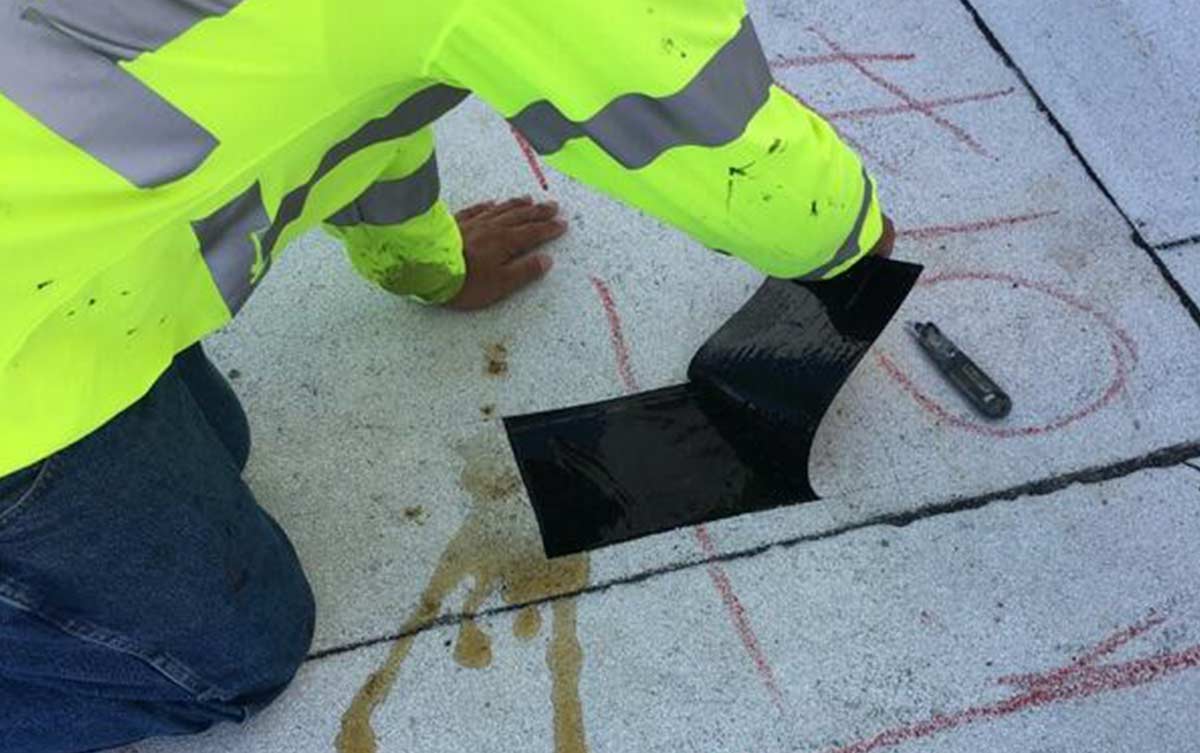
Roof Moisture Scan
The Roof Moisture Scanner employed by Field Verified is recommended to identify all leaks, puncture, and failed seams in the roof membrane that will lead to a reduced service life of the roof system. This test can be performed at the following points in the life cycle of a roofing/waterproofing system:
During or at of installation of a system, to determine whether there was moisture intrusion into the system or materials;
At regular intervals as part of a preventive maintenance program; and,
Before re-roofing or repair work, to assist in determining the extent of work and replacement materials.
A Roof Moisture Scan can be completed at 1/10th the cost of EFVM (Electronic Field Vector Mapping) over a conductive medium. If the roof membrane is new, in serviceable or repairable condition, and does not require total removal, then a Roof Moisture Scan is recommended to identify all leaks, puncture, and failed seams in the membrane that will lead to a reduced service life of the roof system.
Excess moisture trapped in roofing or waterproofing systems can adversely affect performance, as well as lead to premature failure of a system and its components. Using an electrical impedance scanner is a fast and relatively easy way to conduct moisture surveys of roofing and waterproofing systems.
ASTM D7954 Practice for Moisture Surveying of Roofing and Waterproofing Systems Using Non-Destructive Electrical Impedance Scanners covers the use of electrical impedance scanners to monitor the moisture level of a roofing system over various stages of its lifespan.
In the proposed procedure an electrical impedance scanner is moved across the roof surface. Low frequency signals are transmitted non-destructively through the surface, measuring the electrical alternating current impedance. The strength of the signal varies in proportion to the moisture level under the footprint of the scanner, with greater amounts of moisture resulting in higher comparative moisture readings.
If persistent roof leaks exist, especially near penetrations and roof top mechanical curbs, they can be hard to detect by any other method. For this reason, the Roof Moisture Scanner is superior to an infrared scan. The scanner will detect elevated moisture content through the insulation, regardless of ambient conditions.
TAKE ADVANTAGE OF OUR NOT-TO-EXCEED PRICING
Long lead time and high cost of testing has stinted the growth of ELD testing in the construction work. We provide quotes you can count on by providing a Not-To-Exceed price quote. If you have upcoming testing, please contact us to get started on a proposal for your consideration.

